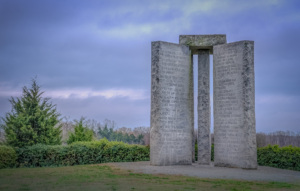‘Satanic’ Georgia Monument Blown Up
Many consider the Georgia Guidestones, located in rural Elberton, Ga., to be one of America’s most mysterious monuments. Etched on its 19-foot slabs are different inscriptions, each translated into eight different languages, as well as ancient Greek and Egyptian hieroglyphics. The capstone reads: “Let these be guidelines to an Age of Reason.”

Georgia Guidestones. Photo credit Dina Eric, wikimedia commons
Early in the morning of July 6, an explosive device was placed at the foot of the monument, demolishing one of the slabs. The remaining slabs became unstable and had to be removed. After 42 years, the Georgia Guidestones were no more – and religious extremists inflamed by conspiracy theories may be responsible.
Since 1980, groups holding different political and religious views have formulated various theories surrounding the messages on the stones. Some saw the monument as a harmless, albeit odd, roadside photo op, while others criticized the stones’ inscriptions that call for people to “guide reproduction wisely” and greatly reduce world population. (Other messages on the stones are more positive – “Protect people and nations with fair laws and just courts” and “Balance personal rights with social duties.”)
For years, the monument has sparked conspiracy theories perpetuated by extremist Christian nationalists and members of QAnon, many of whom believe the structure to be satanic and the constitution for an elite new world order.
To understand the Guidestones, one must know a little about their context. The monument was constructed in 1980 during the Cold War, and the man behind its creation, Robert Christian (believed to be a pseudonym), had intended the monument to be a symbol of hope in the event of a nuclear war. This was a real concern for people at the time, yet this context was often lost on visitors in later years.
While most of the conspiracy theories had remained in right-wing internet forums and chatrooms, Georgia Republican gubernatorial candidate Kandiss Taylor made it clear that removing the monument, which sits on county-owned land, would be her top priority if elected. In May, she tweeted, “Elect me Governor of Georgia, and I will bring the Satanic Regime to its knees – and DEMOLISH the Georgia Guidestones.” After its collapse, she tweeted: “God is God all by Himself. He can do ANYTHING He wants to do. That includes striking down Satanic Guidestones.”
Taylor, who garnered less than 4% of the GOP vote in the May 24 primary, later stated she doesn’t condone vandalism, but her rhetoric and similar outbursts likely contributed to a violent and destructive reaction. Hardly a sign of divine intervention, the bombing has done nothing but harm Elberton’s tourism industry. With one of the town’s central tourist spots demolished, fewer people will make their way into this already isolated area. Local businesses that relied on foot traffic will suffer.
Weaving religion and conspiracy into politics is a dangerous game with serious consequences. While some of the inscriptions on the Guidestones are undoubtedly controversial in this day and age, there were appropriate ways to deal with that.
The people of Elberton should have been given the opportunity to decide how to deal with the Guidestones. And if some residents felt strongly about the matter, they could have gone to court. Resorting to violence was never the solution.


